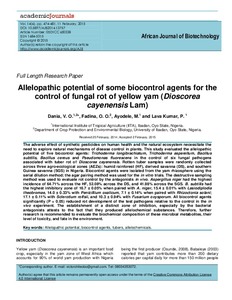| dc.contributor.author | Dania, V.O. |
| dc.contributor.author | Fadina, O.O. |
| dc.contributor.author | Ayodele, M. |
| dc.contributor.author | Lava Kumar, P. |
| dc.date.accessioned | 2019-12-04T10:57:22Z |
| dc.date.available | 2019-12-04T10:57:22Z |
| dc.date.issued | 2015-02-15 |
| dc.identifier.citation | Dania, V. O., Fadina, O. O., Ayodele, M., & Kumar, P. L. (2015). Allelopathic potential of some biocontrol agents for the control of fungal rot of yellow yam (Dioscorea cayenensis Lam). African Journal of Biotechnology, 14(6), 474-481. |
| dc.identifier.issn | 1684-5315 |
| dc.identifier.uri | https://hdl.handle.net/20.500.12478/717 |
| dc.description.abstract | The adverse effect of synthetic pesticides on human health and the natural ecosystem necessitate the need to explore natural mechanisms of disease control in plants. This study evaluated the allelopathic potential of five biocontrol agents: Trichoderma longibrachiatum, Trichoderma asperellum, Bacillus subtilis, Bacillus cereus and Pseudomonas fluorescens in the control of six fungal pathogens associated with tuber rot of Dioscorea cayenensis. Rotten tuber samples were randomly collected across three agro-ecological zones (AEZs): humid rainforest (HF), derived savanna (DS), and southern Guinea savanna (SGS) in Nigeria. Biocontrol agents were isolated from the yam rhizosphere using the serial dilution method; the agar pairing method was used for the in vitro trials. The destructive sampling method was used to evaluate rot control by the antagonists in vivo. Aspergillus niger had the highest incidence of 64.71% across the HF, 52.08% across the DS, and 41.98% across the SGS. B. subtilis had the highest inhibitory zone of 16.7 ± 0.05% when paired with A. niger, 15.4 ± 0.01% with Lasiodiplodia theobromae, 14.0 ± 0.33% with Penicillium oxalicum, 7.1 ± 0.14% when paired with Rhizoctonia solani; 17.1 ± 0.11% with Sclerotium rolfsii, and 10.3 ± 0.94% with Fusarium oxysporum. All biocontrol agents significantly (P = 0.05) reduced rot development of the test pathogens relative to the control in the in vivo experiment. The establishment of a distinct zone of inhibition, especially by the bacterial antagonists attests to the fact that they produced allelochemical substances. Therefore, further research is recommended to evaluate the biochemical composition of these microbial metabolites, their level of toxicity, and fate in the environment. |
| dc.format.extent | 474-481 |
| dc.language.iso | en |
| dc.subject | Tubers |
| dc.subject | Allelochemicals |
| dc.title | Allelopathic potential of some biocontrol agents for the control of fungal rot of yellow yam (Dioscorea cayenensis Lam) |
| dc.type | Journal Article |
| dc.description.version | Peer Review |
| cg.contributor.crp | Roots, Tubers and Bananas |
| cg.contributor.affiliation | International Institute of Tropical Agriculture |
| cg.contributor.affiliation | University of Ibadan |
| cg.coverage.region | Africa South Of Sahara |
| cg.coverage.country | Nigeria |
| cg.authorship.types | CGIAR and developing country institute |
| cg.iitasubject | Research Method |
| cg.iitasubject | Yam |
| cg.journal | African Journal of Biotechnology |
| cg.howpublished | Formally Published |
| cg.accessibilitystatus | Open Access |
| local.dspaceid | 70362 |
| cg.targetaudience | Scientists |
| cg.identifier.doi | https://dx.doi.org/10.5897/AJB2014.13757 |

